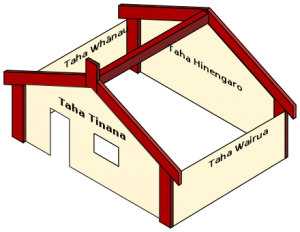A holistic view of health:
Growing up in New Zealand, Māori culture was integrated in my education from a young age. When I studied Physiotherapy at The University of Otago, I learnt about the concept of Hauora. Hauroa is the Māori notion of wellbeing and encompasses four different aspects of health:
1. Taha Tinana:
(Physical well-being). This incorporates the physical body and how it moves, grows and develops. In addition, Taha Tinana involves learning how to care for the body.
2. Taha Hinengaro:
(Mental and emotional well-being). Factors that make up Taha Hinengaro include coherent thinking processes, acknowledging and expressing thoughts/feelings and responding constructively.
3. Taha Whanau:
(Social well-being). Taha Whanau encompasses our personal relationships (family relationships, friendships and other interpersonal relationships). It brings feelings of belonging, compassion and social support
4. Taha Wairua:
(Spiritual well-being). Values, personal identity and life purpose are some of the values that define Taha Wairua. This may or may not include a person’s religious beliefs.

Image credit: https://en.wikipedia.org/wiki/Hauora
How can we take a holistic approach to patient care?
As Physiotherapists, we assess, diagnose and treat physical injuries, pain and imbalances. While it is important to assist the physical injury, the other aspects of a person’s wellbeing are equally important to acknowledge. Here are a few examples of when a client’s injury/pain has been affected by other components of their health:
Example 1:
Mrs R presented to Physiotherapy for rehabilitation following a total knee replacement. During the subjective assessment, I discovered that she was also caring for her elderly husband. Mrs R lacked other social support and this meant that it was difficult for her to undertake her twice-daily exercise plan. Following a discussion around how she was helping her husband, we created a program that incorporated her daily tasks. Along with improving her mobility, strength and endurance, Mrs R was able to include her husband as part of her rehabilitation.
Example 2:
Miss L presented to Physiotherapy with recurrent knee pain that seemed outside of normal injury parameters. I noticed that she was highly anxious when discussing her pain and provoking factors. When I asked Miss L how she was coping with her injury, she confessed that it had caused a huge upheaval to her fitness regime and therefore, her mental health. It then occurred to me to suggest she seek the guidance of a Psychologist or Counsellor. This would enable her to address the psychological components of her pain and improve her overall health.
Example 3:
Mr T presented to PMPP wanting to start Clinical Pilates. Having been diagnosed with a chronic illness that affected balance and mobility, I asked him to describe what he would like to achieve from his sessions. Contrary to my assumption, that he mainly wanted to improve balance and strength, Mr T explained that his main priority was getting on and off the toilet by himself. Had I not taken the time to ask his goals, or assumed that I knew them, I wouldn’t have been able to make a program specific to this important objective.

Taking a holistic approach to a client’s wellbeing ensures that all four aspects of their health are taken care off.
Physical health considerations:
Under the Taha Tinana (physical well-being) umbrella, it is important to address a number of different variables. These include:
- Sleep – quantity, quality and sleep hygiene. Read this blog to learn more: https://
portmelbournephysio.com.au/ sleep-and-the-consequences-of- sleep-deprivation/ https:// portmelbournephysio.com.au/ sleep-hygiene/ - Physical exercise, especially incidental exercise: https://
portmelbournephysio.com.au/ incidental-exercise-the-key- to-helping-keep-off-those- kilos/ - Nutrition: https://
portmelbournephysio.com.au/ surviving-lockdown-healthy- eating-habits-a-positive- mindset/ - Hydration: https://
portmelbournephysio.com.au/ staying-hydrated-over-summer/ - Stress management: https://
portmelbournephysio.com.au/ stress-can-affect/
~ Ali Minichiello

